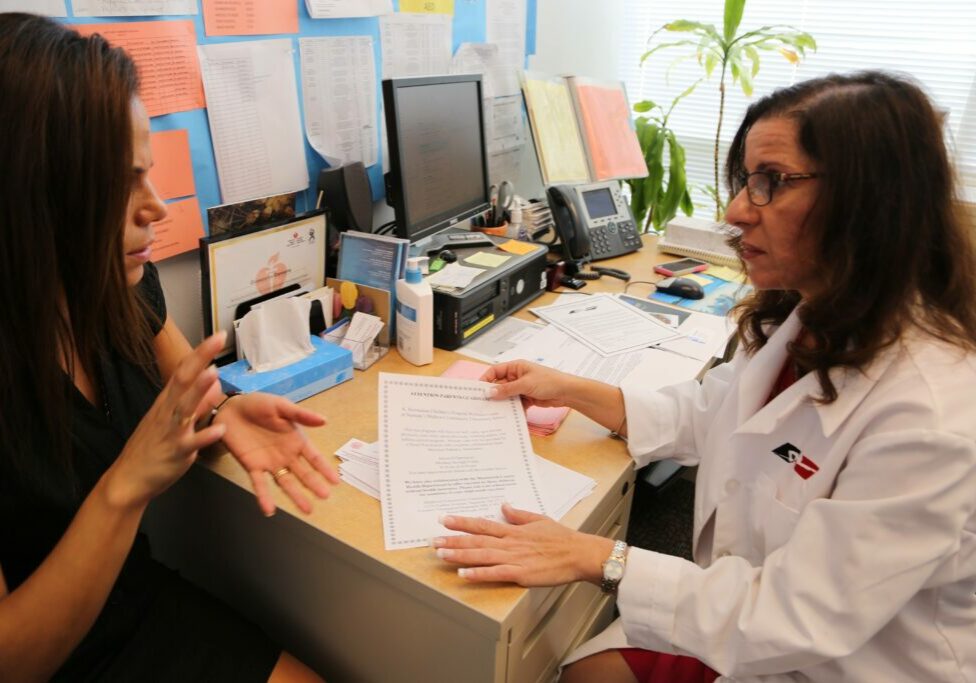New Jersey school nurses are a treasure! They are highly trained to address virtually any health condition they encounter, as well as to educate children, staff, and parents. They train children on basic hygiene and safety; run clinics for children with chronic diseases; train older children on drugs, alcohol, and sexually transmitted diseases and help find recovery programs for them; and train staff on chronic and infectious diseases.
Often they are the only healthcare available to uninsured children, and act as a referral service for glasses, dental care, OB-GYN, and family planning. They must also explain new and upcoming laws to administrators and annually assess nurse staffing needs.
 Increasing demands on nurses
Increasing demands on nurses
If that sounds like a full plate, it is only becoming heaped with more responsibilities. Chronic diseases among children have increased dramatically in recent decades: In the last 30 years, type 2 diabetes has doubled in children and tripled in adolescents, asthma cases have doubled, and obesity has more than doubled. In the last decade, food allergies have increased nearly 20 percent among children.
Chronic conditions put more demands on nurses, such as planning and administering care, and ensuring the school is safe from triggers for respiratory and food allergies and asthma. In 1975 the federal Individuals with Disabilities Education Act (IDEA) brought children with disabilities into the public schools, many with complex health problems, such as tracheotomies, feeding tubes and cystic fibrosis, which demand daily nurse attention. Under the law, nurses conduct screenings, help prepare individualized healthcare and emergency care plans, and carry out paperwork and reporting.
Care spills over to staff
Because many chronically ill and disabled children require medication, frequent monitoring, and emergency response, all staff may be involved—from classroom teachers to bus drivers. Diabetic children on their way to the nurse’s office may be weak and dizzy; a custodian in the hall may be the person who finds them. Cafeteria aides may find themselves assisting diabetic children with counting carbohydrates. Any staff member can volunteer to be trained by the nurse to use EpiPens for anaphylaxis (potentially fatal state of shock) caused by allergies.
Delegating creates liability and tension
For other treatments, the state Nursing Practice Act determines what the nurse can delegate, but does not require her to do so. It is up to nurses to decide to whom they delegate responsibility. Delegated tasks may include administering glucagon for diabetes emergencies and daily personal hygiene or medication for disabled students.
In 2010 New Jersey passed the Students with Diabetes Law (N.J.S.A. 18A:40-12), which allows the school nurse to train volunteers to administer glucagon when the nurse is not physically present. NJEA cautions staff not to volunteer, as they would take on potential liability in giving glucagon. NJEA reminds those who choose to volunteer that there is a requirement that training must be conducted by the school nurse. Those volunteers should also recognize the importance of periodic re-training, documentation of training, and written documentation of their designation as a volunteer.
Nurses are often reluctant to delegate, especially to unlicensed assistance personnel (UAPs), who are often minimally trained in healthcare, because the nurse is liable for what the trainee does, and the nurse’s license is at stake. This may put them at odds with administrators who seek to control costs by hiring UAPs.
Are there enough school nurses?
Whether you look at the ratio of nurses to students or nurses to schools, there are not enough school nurses in every district in New Jersey. Even as the school population in New Jersey has increased and chronic illness has soared, there has not been a significant increase in school nurses in the past ten years, according to Judith Woop, executive director of the New Jersey State School Nurses Association.
Nurse to students
The National Association of School Nurses (NASN) recommends school nurse to student ratios based on student populations. For general populations, they recommend one nurse per 750 students. For populations with complex health care needs, they suggest at least one nurse to 125 students, depending on severity of student needs. Sometimes one nurse per student is required for severely disabled students.
In New Jersey there was one nurse to 533 students in 2010 (the most recent figure available) according to the NASN. In Camden High School the ratio is 1:400, though the population warrants 1:225, under NASN guidelines.
Nurse to schools
New Jersey law requires at least one certified school nurse in each district. Most districts have more than that, often one per building. However, more are needed in large schools with high demand students. In many districts, nurses are responsible for more than one school.
How is need determined?
New Jersey law requires school nurses to assess the staffing needs in their district each year, based on the health needs of the student population, and write a Nursing Service Plan. But the district is not required to provide the staffing they recommend, resulting in lapses of coverage and s chools scurrying to find substitutes for an absent nurse. Results can be serious, as when a student had a diabetes emergency on a day when there was no nurse in his school.
Monetary threats to staffing and credentials
Besides a push to hire UAPs, some districts seek to replace full time nurses with part time nurses or lower-paid LPNs. In addition, there is pressure to save money by decreasing the requirements for school nurse training. Last summer, the State Board of Education passed a New Jersey Department of Education regulation that eliminates the field practicum requirement for instructional nurses, in favor of on-the-job experience.
“We should seek to increase our educational requirements in our discipline, not reduce them,” said Camden High School nurse Julia Henderson. “Would they ever ask a doctor to get less education so they could afford him?”
